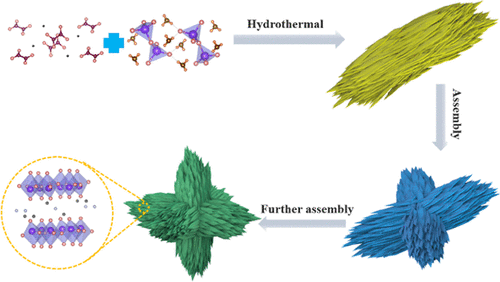当前位置:
X-MOL 学术
›
ACS Sustain. Chem. Eng.
›
论文详情
Our official English website, www.x-mol.net, welcomes your
feedback! (Note: you will need to create a separate account there.)
Intercalation Mechanism of the Ammonium Vanadate (NH4V4O10) 3D Decussate Superstructure as the Cathode for High-Performance Aqueous Zinc-Ion Batteries
ACS Sustainable Chemistry & Engineering ( IF 7.1 ) Pub Date : 2021-08-25 , DOI: 10.1021/acssuschemeng.1c03101 Rui Sun 1, 2 , Zhaoxia Qin 1, 2 , Xinlong Liu 2 , Caihong Wang 1 , Shengjun Lu 1 , Yufei Zhang 3 , Haosen Fan 2
ACS Sustainable Chemistry & Engineering ( IF 7.1 ) Pub Date : 2021-08-25 , DOI: 10.1021/acssuschemeng.1c03101 Rui Sun 1, 2 , Zhaoxia Qin 1, 2 , Xinlong Liu 2 , Caihong Wang 1 , Shengjun Lu 1 , Yufei Zhang 3 , Haosen Fan 2
Affiliation

|
Aqueous zinc-ion batteries (AZIBs) are promising candidates for practical energy storage due to their superior energy density, nontoxicity, and environmental friendliness. However, it is still a tremendous quest to seek an outstanding cathode material to reach a splendid rate property as well as stable long-term cycle property. Herein, we present a self-template method to synthesize NH4V4O10 with a decussate structure and the intercalation mechanism via a simple one-step hydrothermal method, which delivers a prominent mass energy density of 332.25 W h kg–1, excellent rate performance, and a stable long-time cycle. Attributing to its specific decussate morphology consisting of vast vertical nanobelts and the intercalation of NH4+ with hydrogen bonding between ammonium ions and vanadium oxide layers as a “pillar” in the V2O5 host, the NH4V4O10 electrode material can effectively prevent structural collapse as well as promote the rate of electronic diffusion in the de(intercalation) process of Zn2+. Importantly, the materials not only deliver 243 and 221.4 mA h g–1 (98.7 and 90% retention of initial discharge capacity of 246 mA h g–1, respectively) in 1480 cycles and 2100 cycles, respectively, at 5 A g–1 but also maintain a specific capacity of 417.35 mA h g–1 at 0.1 A g–1 in the 150th cycle, which delivers a superior property compared with the previously reported metal-intercalated V2O5. Therefore, this work provides the direction to choose and design a novel cathode material with a peculiar morphology and admirable performance for AZIBs and other secondary batteries.
中文翻译:

钒酸铵 (NH4V4O10) 3D 交叉结构作为高性能锌离子水电池阴极的插层机制
水系锌离子电池(AZIBs)由于其优越的能量密度、无毒和环境友好性而成为实用储能的有希望的候选者。然而,寻找一种优异的正极材料以达到优异的倍率性能和稳定的长期循环性能仍然是一项艰巨的任务。在此,我们提出了一种自模板法,通过简单的一步水热法合成具有交叉结构和插层机制的NH 4 V 4 O 10,该方法提供了 332.25 W h kg –1的显着质量能量密度,非常出色。率性能,和稳定的长周期循环。归因于其特定的交叉形态由巨大的垂直纳米带和 NH 的嵌入组成4 +以铵离子和氧化钒层之间的氢键作为 V 2 O 5主体中的“支柱” ,NH 4 V 4 O 10电极材料可以有效防止结构坍塌并促进电子扩散速率Zn 2+ 的脱(嵌入)过程。重要的是,这些材料不仅在 5 A g –1 的1480 次循环和 2100 次循环中分别提供 243 和 221.4 mA hg –1(分别保持 246 mA hg –1初始放电容量的 98.7% 和 90% ),而且在 0.1 A g 时保持 417.35 mA hg –1的比容量–1在第 150 次循环中,与之前报道的金属嵌入 V 2 O 5相比,它提供了优越的性能。因此,这项工作为选择和设计具有独特形态和优异性能的新型正极材料用于 AZIBs 和其他二次电池提供了方向。
更新日期:2021-09-06
中文翻译:

钒酸铵 (NH4V4O10) 3D 交叉结构作为高性能锌离子水电池阴极的插层机制
水系锌离子电池(AZIBs)由于其优越的能量密度、无毒和环境友好性而成为实用储能的有希望的候选者。然而,寻找一种优异的正极材料以达到优异的倍率性能和稳定的长期循环性能仍然是一项艰巨的任务。在此,我们提出了一种自模板法,通过简单的一步水热法合成具有交叉结构和插层机制的NH 4 V 4 O 10,该方法提供了 332.25 W h kg –1的显着质量能量密度,非常出色。率性能,和稳定的长周期循环。归因于其特定的交叉形态由巨大的垂直纳米带和 NH 的嵌入组成4 +以铵离子和氧化钒层之间的氢键作为 V 2 O 5主体中的“支柱” ,NH 4 V 4 O 10电极材料可以有效防止结构坍塌并促进电子扩散速率Zn 2+ 的脱(嵌入)过程。重要的是,这些材料不仅在 5 A g –1 的1480 次循环和 2100 次循环中分别提供 243 和 221.4 mA hg –1(分别保持 246 mA hg –1初始放电容量的 98.7% 和 90% ),而且在 0.1 A g 时保持 417.35 mA hg –1的比容量–1在第 150 次循环中,与之前报道的金属嵌入 V 2 O 5相比,它提供了优越的性能。因此,这项工作为选择和设计具有独特形态和优异性能的新型正极材料用于 AZIBs 和其他二次电池提供了方向。




















































 京公网安备 11010802027423号
京公网安备 11010802027423号